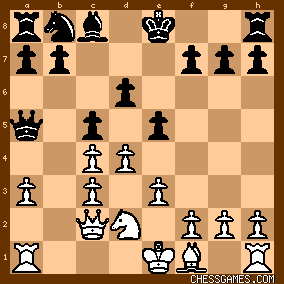keypusher: Position after 10....e5:

click for larger viewSF11 doesn't quite trash this classic (cf. Botvinnik vs Panov, 1939), but it doesn't do it lots of favors. SF slightly prefers 11.Bd3 (+0.51, 49 ply) to 11.dxe5 (+0.33, 49 ply). The main line after 11.Bd3 runs 11....cd 12.cd ed 13.0-0! Qc3 14.ed Qxc2 15.Rfe1+ Kd8 16.Bxc2 with a lead in development -- useful even in the endgame, as Bronstein pointed out. <Naniwazu: <mathematician> John Watson gives the variation 14...exf4 15. exf4 f5 (to prevent f5) and points out that White has the open e-file and an outpost on e5. (Secrets of Modern Chess Strategy, p. 51).> Watson's note doesn't hold up. Instead of 15....f5, 15....Bd7 and the supposed threat of 16.f5 is met with 16....Ba4 17.Qc1 Rd8 (-0.13, 46 ply). As the game went, White had a very slight advantage that got bigger after 20....Ba6?! and 24....Rd8?. After 26....Bc8? White was winning. <Why no more kibitzing for this famous game?> Seems to be more famous than it deserves. White was definitely not winning after 11.dxe5, in any case. | 




